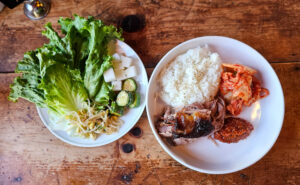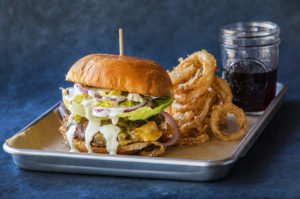
I think all cooks, from the diligent amateur to the dedicated professional, have at least a little bit of OCD in their bones. The commercial cook exemplifies this: Why else would someone repeatedly construct the same thing, in precisely the same manner, under extreme and unrelenting pressure, with the specific aim, not only of doing it well, but of doing it the same way, every time that knife meets board or a pan clangs down on a flat-top? Not that that’s a bad thing. To the contrary, that trendy new place you’ve been gagging to try, the innumerable souls saved by much-needed hangover brunches, and every great sushi bar all depend on it. Can you imagine playing Russian roulette with the crust at your favorite pizza joint, the done-ness of your steak, or the hardness of your egg? Take away the obsessive cooks, and we’d all be eating Swanson’s Hungry Man or instant ramen with a spork.
All of which is by way of an introduction to our latest installments of Why I’m Trying To Make Perfect Mac-n-Cheese (earlier attempts: here and here). My wife will testify to the mountains of grated cheese, the errors like some pagan fortune engraved in burnt milk at the bottom of sauce pots, the sweet, nutty smell of flour frying in butter that fill the house, and – finally – to today’s lesson, in which I learn that, unlike Crisco or tickling, if some is good, then more is better.
I can’t claim that my perfect mac-n-cheese will also be yours – we may, and likely do, have different ideas about the Platonic ideal of this American classic, as heterogeneous as it is both ubiquitous and variously successful – or even that I’ll leave well enough alone; as it happens, I’m still not entirely convinced of the winner of the Great Bechamel Debate, and I’ll be back here next week, working on some flour-free derivatives, specifically for that reason. I can, however, state definitively that this bad boy – all gooey, creamy, sharp, melted, cheesy goodness, with layers of richly textured pasta, glowing with a naturally-infused orange that Kraft’s chemical engineers would envy, and infused with a distinctly adult intensity and depth of flavor – is fairly serious stuff. If your ideal steak is warm in the center, or you’re certain that chocolate pudding should only be made with milk chocolate, then I probably can’t help you, but that shouldn’t stop you from trying to perfect it anyway; there may be objective standards of taste, but you still have little choice but to cook to your own palate – you just need to accept that, like my image of the ideal my mac-n-cheese, the elusive version casting shadows on the cave wall remains intensely personal.
This particular one is a bit of a pain in the ass, particularly for so pedestrian a dish, and one for which a more modest effort will still produce acceptable results (you could skip the onion brulee, the milk-poaching, and the AR noodle arrangement, for instance). But this isn’t about acceptable, it’s about perfecting something, and that means there are more corners not to cut, some longer blocks to traverse.
Mac-n-Cheese, Cheese, and More Cheese (v2.5)
-

Typical Onion Brulee
Bring a gallon of salted whole milk to a gentle simmer (don’t scorch it – if you do, throw it out and start over, it will be irredeemable and will ruin the entire dish) in a pasta pot and prep a half a sweet (Vidalia, Maui, Walla Walla) onion and make an onion brulee: Stud the onion with a few cloves, put a single bay leaf in a knife-slit in the top, and grill it in a plan until the onion begins to soften and the underside turns a deep caramel color. Preheat a 350F oven. (The milk-poaching comes courtesy of a recipe from Alain Ducasse, but I can’t find the link.) - Grate 1+1/3 pound of aged Mimolette or Cheddar, plus 1/3 pound each of cave-aged Gruyere, Appenzeller, and yellow American cheeses (other “fondue” style cheeses would work just as well; and you can grate the American off a block, or just tear up slices). Once the onion is done, add it to 6 cups of whole milk and warm it up (it doesn’t need to boil but it does need to be hot, or the sauce will get lumpy). While the milk and onion are warming, cook 1/2 cup of flour into 3/4 cup of butter for a light blonde roux in a sauce pot.
- Add two pounds (it might be 1kg, depending on the brand) of high quality boxed penne (preferably not regate), three whole, peeled cloves of garlic, and some white pepper corns to the pasta pot and poach the pasta until just shy of al dente, stirring to prevent sticking. If it’s a good Italian brand, you’ll want to take it off about 1 minute before the lower end of their suggested cooking range (it should be just barely too undercooked to eat, as this will allow it to finish cooking in the sauce). Stir the pasta from time to time to prevent the noodles from sticking to each other (the milk makes this a little trickier than normal).
- While the pasta is cooking, make the cheese sauce; Whisk the hot, onion-infused milk into the roux, in order to make a thick bechamel. If it lumps a little, don’t stress, we’ll strain it out later. Bring up to a gentle boil, back off the heat, and season with salt, white pepper, and nutmeg (something like a and 1/8 teaspoon each nutmeg and pepper, bu you’ll need to adjust to taste – it should be neither salty nor peppery nor bland, with just the slightest background note of baking spice from the nutmeg). Whisk in 1 teaspoon each of mustard powder and sweet (not hot) paprika (the paprika should have a rich, dark red color; if it looks dark brown and dirty, it’s either too old or of poor quality). Grind a small pinch of saffron threads between your fingers and stir in. In addition to flavor, the mustard-paprika-saffron seasoning is the secret to a great color. Finally, once the base for the sauce has been finished, stir in 1lb of the Mimollette or Cheddar and all of the Gruyere, Appenzeller, and American cheeses, working in large handfuls. When the sauce is uniformly blended and smooth, check the seasoning, and turn off the heat. If it has any lumps, or hard ends of cheese, or anything else that is not uniformly smooth, run it through a chinois or fine-mesh strainer.
- Either during or after making the sauce, drain the pasta when finished, making sure to remove the garlic cloves and peppercorns. Shake the noodles gently so that they don’t clump together.
-

Layering the pasta and sauce
In order to assemble the casserole, lightly butter a 9×13 baking dish, and alternate single layers of pasta and sauce, and beginning and ending with a layer of sauce. When laying down the pasta, line up the little pencils end to end in neat, parallel rows, alternating direction by 90 degrees – check out the picture. (Yes, it’s a pain, but it looks really cool and, more importantly, allows the final product to set up and to be cut in neat shapes for service.) After the last row of pasta, add an extra thick layer of sauce, and then top it with the final 1/3lb of the grated Mimolette. (Note, based on your exact baking dish, pasta quantity, evaporation while cooking, and personal touch, you may or may not use all of the pasta, sauce or both – it’s not a big deal, just make sure that each layer of pasta is covered and that you begin and end with sauce, the rest will take care of itself.) - Bake at 350F for 20-25 minutes, until bubbling up the sides. Remove, let rest for 10 minutes, return to the oven and broil the top until golden brown and bubbly – this will ensure that you can serve neat, “set” pieces, that they food is piping hot, and a cheesy crust on top, all important features, as long as we’re going for “perfect”.









